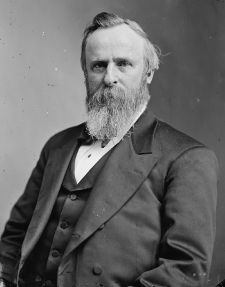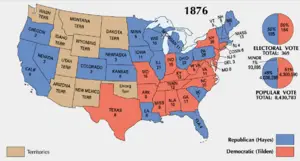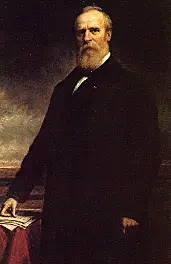Rutherford B. Hayes
| Term of office | March 4, 1877 – March 3,1881 |
| Preceded by | Ulysses S. Grant |
| Succeeded by | James A. Garfield |
| Date of birth | October 4, 1822 |
| Place of birth | Delaware, Ohio |
| Date of death | January 17, 1893 |
| Place of death | Fremont, Ohio |
| Spouse | Lucy Ware Hayes |
| Political party | Republican |
Rutherford Birchard Hayes (October 4, 1822 – January 17, 1893) was an American politician, lawyer, military leader and the 19th President of the United States (1877-1881).
Early political career
Hayes was born in Delaware, Ohio, on October 4, 1822. He was born to Rutherford Hayes and Sophia Birchard and was the youngest of four children, however two of them, Lorenzo and Sarah Sophia died young. Hayes's father died before Hayes was born and an uncle, Sardis Birchard, lived with the family and served as Hayes's guardian. Hayes attended the common schools and the Methodist Academy in Norwalk, Ohio. He graduated from Kenyon College in Gambier, Ohio in August 1842 and from Harvard Law School in January 1845. He was admitted to the bar on May 10, 1845, and commenced practice in Lower Sandusky (now Fremont, Ohio). He moved to Cincinnati, Ohio in 1849 and resumed the practice of law. He was city solicitor from 1857 to 1859.
Civil War Service
Despite being nearly 40 at the outbreak of the Civil War, Hayes joined as a three-year volunteer and was commissioned as a majorof the 23rd Ohio Infantry, on June 27, 1861 despite having no previous military experience. Promoted to lieutenant colonel on October 24, 1861, Hayes was severely wounded at the Battle of South Mountain while commanding the 23rd at Fox Gap when a musket ball struck him in the left arm above the elbow. The ball fractured but did not splinter the bone, which would have necessitated amputation of the limb. He was promoted to colonel on October 24, 1862, and he commanded a brigade at the battle of Cloyd's Mountain. He was promoted to brigadier general of Volunteers on October 9, 1864, during the Shenandoah Valley Campaign of 1864. He received a Brevet (military) to major generalof Volunteers on March 3, 1865.
Political service
While still in the Shenandoah in 1864, Hayes received the Republican nomination to Congress from Cincinnati. Refusing to campaign on the grounds that "an officer fit for duty who at this crisis would abandon his post to electioneer for a seat in Congress ought to be scalped," Hayes was elected and served in the Thirty-ninth United States Congress and again to the Fortieth United States Congress Congresses and served from March 4, 1865, to July 20, 1867, when he resigned, having been nominated for Governor of Ohio. Through the powerful voice of his friend and Civil War subordinate James M. Comly's Columbus Citizen-Journal (one of the state's most influential newspapers), Hayes won the election and served as governor from 1868 to 1872. He was an unsuccessful candidate for election to the Forty-third United States Congress. He was again elected governor and served from January 1876 to March 2, 1877.
Election of 1876
U.S. presidential election, 1876 Hayes became president after the tumultuous, scandal-ridden years of the Grant administration. He had a reputation for honesty dating back to his Civil War years. As Governor of Ohio, his scrupulousness sometimes dismayed even his political allies, and Hayes was nicknamed "Old Granny." Hayes was quite famous for his ability to not offend anyone. Henry Adams, a prominent politician at the time, asserted that Hayes was "a third rate nonentity, whose only recommendation is that he is obnoxious to no one." Nevertheless, his opponent in the presidential election, Democrat Samuel J. Tilden, was the favorite to win the presidential election and, in fact, won the popular vote by about 250,000 votes with about 8.5 million voters in total.
Four states' electoral college votes were contested. In order to win, the candidates had to muster 185 votes: Tilden was short just one, with 184 votes, Hayes had 165, with 20 votes representing the four states which were contested. To make matters worse, three of these states (Florida, Louisiana, and South Carolina) were in the South, which was still under military occupation (the fourth was Oregon). Additionally, historians note, the election was not fair because of the improper fraud and intimidation perpetrated from both sides. A popular phrase of the day called it an election without "a free ballot and a fair count."
To peacefully decide the results of the election, the two houses of Congress set up the Electoral Commission to investigate and decide upon the actual winner. The commission constituted 15 members: five from the House, five from the Senate and five from the Supreme Court. Additionally, the Commission was bi-partisan consisting of 7 Democrats, 7 Republicans and a "swing" vote in Joseph P. Bradley, a Supreme Court Justice. Bradley, however, was a Republican at heart and thus the ruling followed party lines: 8 to 7 voted for Hayes winning in all of the contested 20 electoral votes.
Key Ohio Republicans like James A. Garfield and the Democrats, however, agreed at a Washington hotel on the Wormley House Agreement. Southern Democrats were given assurances that if Hayes became president, he would pull federal troops out of the South and end Reconstruction. An agreement was made between them and the Republicans: if Hayes's cabinet consisted of at least one Southerner and he withdrew all Union troops from the South, then he would become President. This Compromise of 1877 is sometimes considered to be the second Corrupt Bargain.
Presidency 1877-1881
Because March 4, 1877 was a Sunday, Hayes took the oath of office in the Red Room of the White House on March 3. He took the oath again publicly on March 5 on the East Portico of the United States Capitol, and he served until March 3, 1881.
Domestic policy
In domestic affairs, aside from reconciliation with the South, his administration was noteworthy for two achievements, both giving evidence of a strong president resolute in his relations with Congress: resumption of specie (mainly gold) backing of the paper currency and bonds that financed the war, and the beginning of civil service reform. Hayes' first step in civil service reform was to issue an executive order in June 1877 forbidding federal civil servants to take an active part in politics. This order brought him into fateful collision with congressional spoilsmen. In this mainly victorious test, Hayes removed not only a subordinate, Alonzo B. Cornell, from the New York customhouse but also the port collector, Chester A. Arthur, both Republicans. (When Arthur himself became president, he backed major civil service reform legislation, so that the sequel to this explosive episode was another irony.) Hayes also won a significant duel with Congress over riders attached to army appropriation bills to keep him from protecting blacks' rights to vote in line with the 15th Amendment.
Foreign policy
In 1878, Hayes was asked by Argentina to act as arbitrator following the War of the Triple Alliance between Argentina, Brazil and Uruguay against Paraguay. The Argentines hoped that Hayes would give the Chaco region to them; however, he decided in favor of the Paraguayans. His decision made him a hero in Paraguay, and a city Villa Hayes and a department were named in his honor.
But for the most time, Hayes wasn't very much involved in foreign policy. Most of the problems during his time in office were small and insignificant.
Notable legislation
During his presidency, Hayes signed a number of bills including one signed on February 15, 1879 which, for the first time, allowed female attorneys to argue cases before the Supreme Court of the United States.
Other acts include:
- Compromise of 1877
- Desert Land Act (1877)
- Bland-Allison Act (1878)
- Timber and Stone Act (1878)
Significant events during his presidency
- Munn v. Illinois (1876)
- Great Railroad Strike (1877)
Administration and Cabinet
| OFFICE | NAME | TERM |
| President | Rutherford B. Hayes | 1877–1881 |
| Vice President | William A. Wheeler | 1877–1881 |
| Secretary of State | William M. Evarts | 1877–1881 |
| Secretary of the Treasury | John Sherman | 1877–1881 |
| Secretary of War | George W. McCrary | 1877–1879 |
| Alex Ramsey | 1879–1881 | |
| Attorney General | Charles Devens | 1877–1881 |
| Postmaster General | David M. Key | 1877–1880 |
| Horace Maynard | 1880–1881 | |
| Secretary of the Navy | Richard W. Thompson | 1877–1880 |
| Nathan Goff, Jr. | 1881 | |
| Secretary of the Interior | Carl Schurz | 1877–1881 |
Supreme Court appointments
Hayes appointed two Associate Justices of the Supreme Court of the United States:
- John Marshall Harlan – 1877
- William Burnham Woods – 1881
States admitted to the Union
None
Post-Presidency
Hayes did not seek re-election in U.S. presidential election, 1880, keeping his pledge that he would not run for a second term. He had, in his inaugural address, proposed a one-term limit for the presidency combined with an increase in the term length to six years.
Rutherford Birchard Hayes died of complications of a heart attack in Fremont, Ohio, Sandusky County, Ohio, at 11:00 p.m. on Tuesday January 17, 1893. Interment was in Oakwood Cemetery. Following the gift of his home to the state of Ohio for the Spiegel Grove State Park, he was reinterred there in 1915.
Trivia
- Hayes was the last U.S. President born before the Monroe Doctrine came into effect.
- Hayes was the first U.S. President to visit the West Coast of the United States while in office.
- Hayes is also reputed to be the first President to have had his voice recorded—by Thomas Edison in 1877 with his newly-invented phonograph. Unfortunately, the tin it was recorded on has been lost. As the recording cannot be located, some say that it never existed, and that therefore the first President to have his voice recorded was Benjamin Harrison in the 1890s.
- Hayes has both a city (Villa Hayes) and a department (Presidente Hayes) named after him in Paraguay. Hayes arbitrated a dispute between Argentina and Paraguay in Paraguay's favor and was honored in gratitude.
External links
- Inaugural Address
- The Rutherford B. Hayes Presidential Center Fremont, Ohio
- White House Biography
- Grant Succumbs to Temptation, Hayes Gets the Nod (1876) William Archibald Dunning recounts how President Grant refuses a third term in language so equivocal that it amounts to encouragement for his partisans. The result is a Congressional warning and the nomination of Rutherford B. Hayes.
- http://www.ohiohistory.org/onlinedoc/hayes/chapterxii.html
- Works by Rutherford B. Hayes. Project Gutenberg
- Rutherford Hayes' Gravesite
| Preceded by: Alexander Long |
U.S. Congressman for Ohio's 2nd district 1865 – 1867 |
Succeeded by: Samuel F. Cary |
| Preceded by: Jacob D. Cox |
Governor of Ohio 1868 – 1872 |
Succeeded by: Edward F. Noyes |
| Preceded by: William Allen |
Governor of Ohio 1876 – 1877 |
Succeeded by: Thomas L. Young |
| Preceded by: Ulysses S. Grant |
Republican Party presidential candidate U.S. presidential election, 1876 (won) |
Succeeded by: James A. Garfield |
| Preceded by: Ulysses S. Grant |
President of the United States March 4, 1877 – March 3, 1881 |
Succeeded by: James A. Garfield |
| |||||||
| |||||
Template:OHGovernors
Credits
New World Encyclopedia writers and editors rewrote and completed the Wikipedia article in accordance with New World Encyclopedia standards. This article abides by terms of the Creative Commons CC-by-sa 3.0 License (CC-by-sa), which may be used and disseminated with proper attribution. Credit is due under the terms of this license that can reference both the New World Encyclopedia contributors and the selfless volunteer contributors of the Wikimedia Foundation. To cite this article click here for a list of acceptable citing formats.The history of earlier contributions by wikipedians is accessible to researchers here:
The history of this article since it was imported to New World Encyclopedia:
Note: Some restrictions may apply to use of individual images which are separately licensed.






